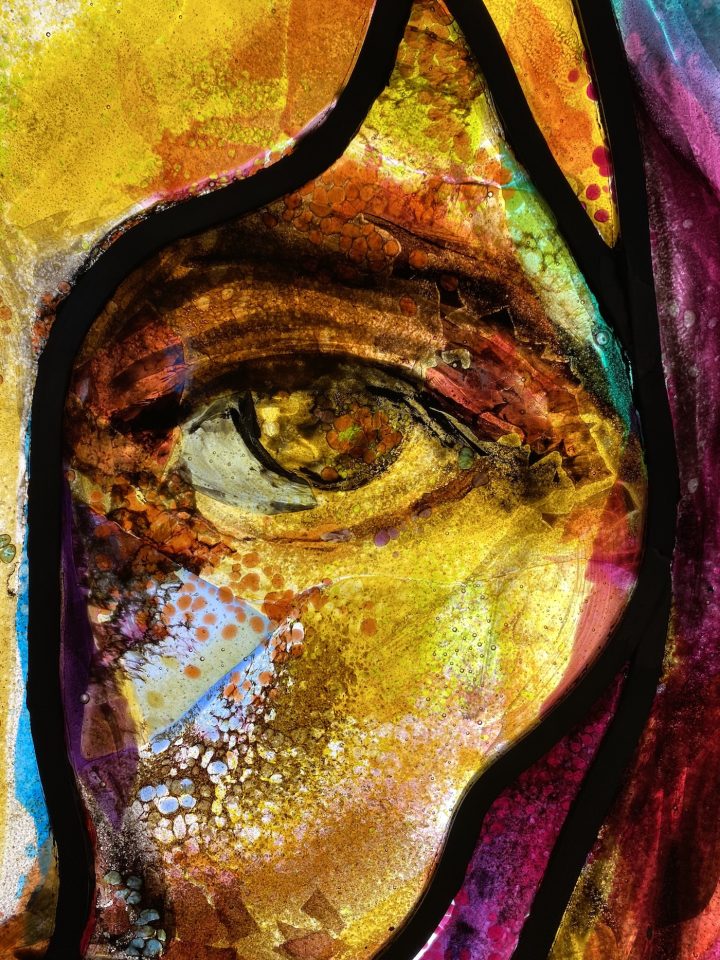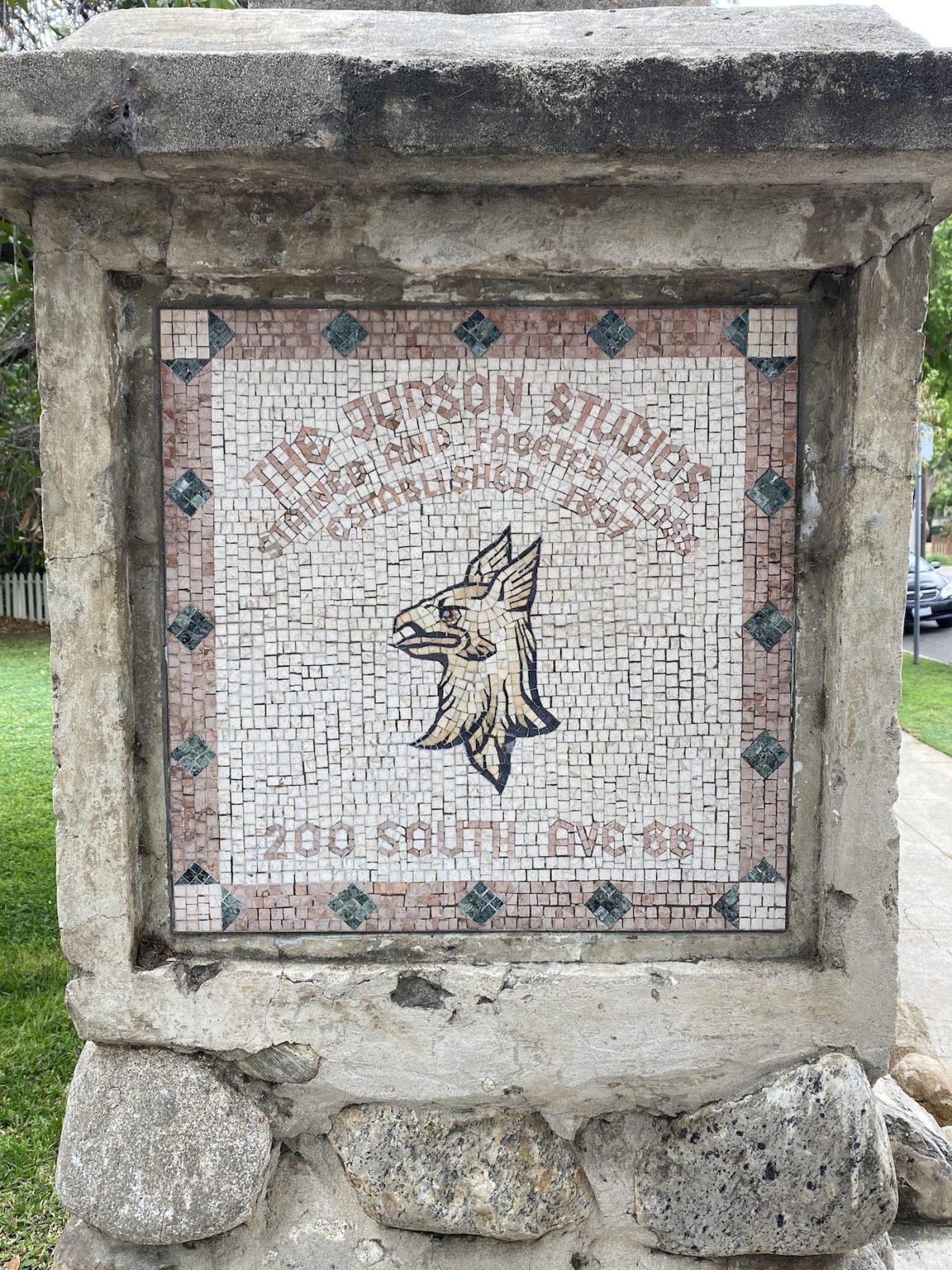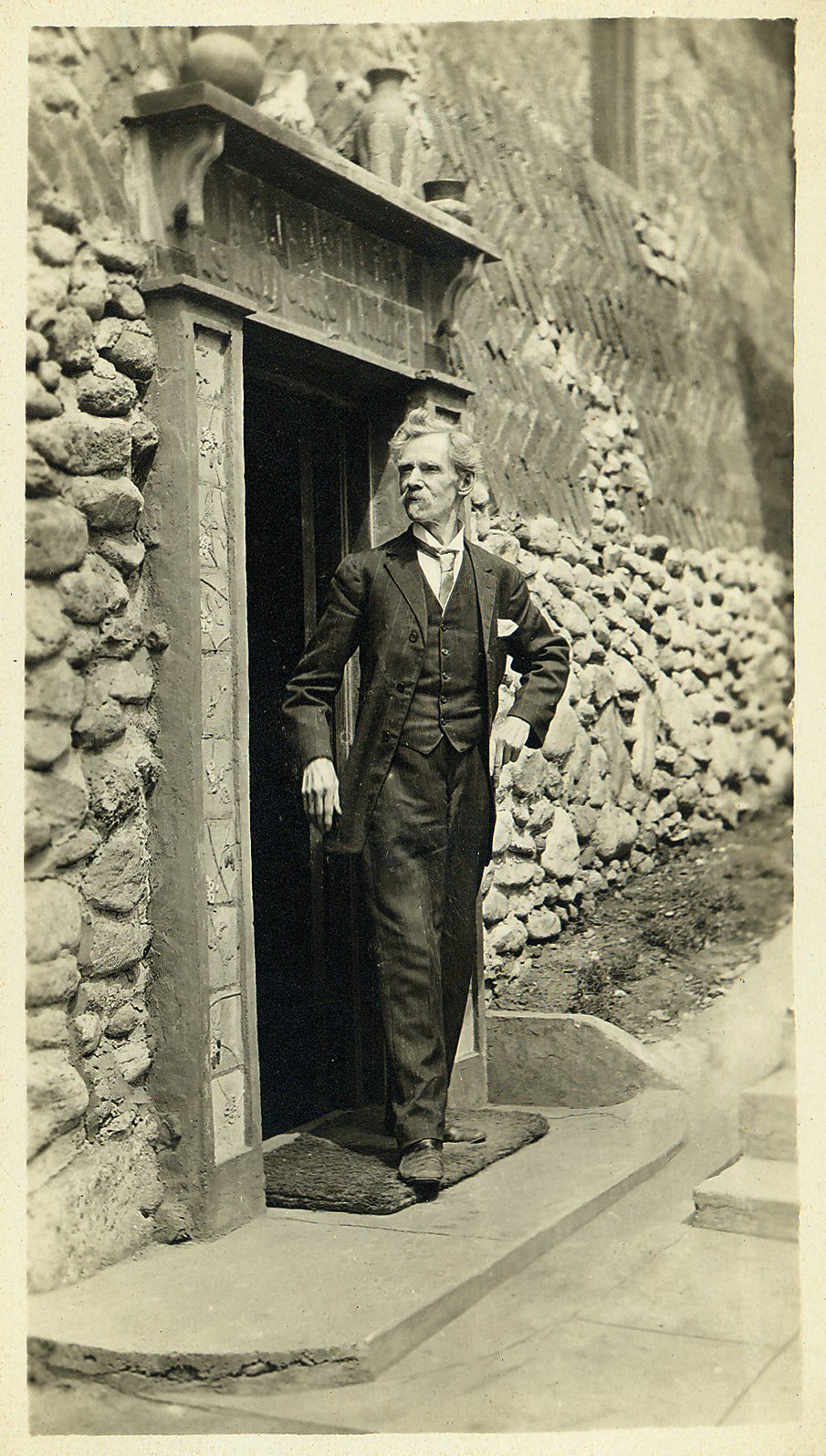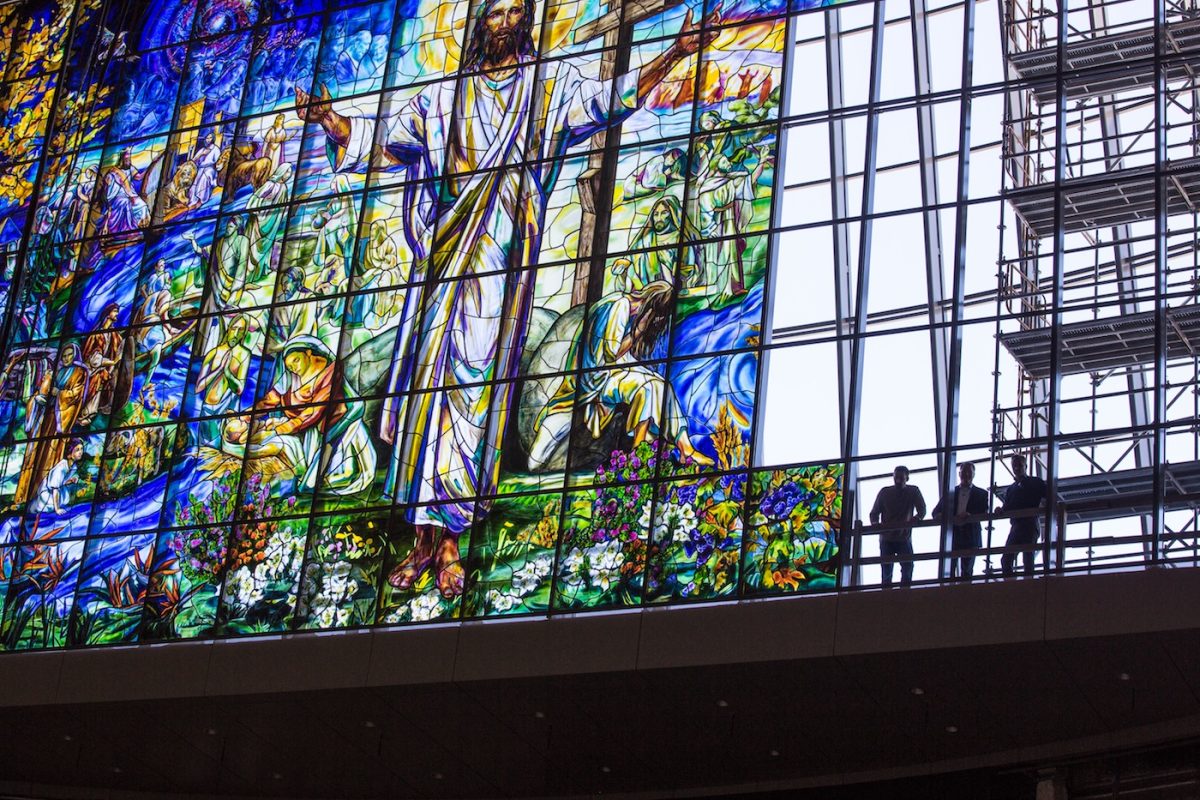
LOS ANGELES — Judson Studios, founded 124 years ago, is the oldest family-run art glass studio in the country. It began working with stained glass, a medium whose technique has remained essentially unchanged since the Middle Ages, at a time when Los Angeles was establishing itself as a truly modern metropolis. It continued to design hand-crafted, labor-intensive glassworks throughout the 20th century, applying the centuries-old process to a range of styles and aesthetics, from Beaux-Arts to Arts & Crafts, and Mid-Century Modern. More recently, Judson Studios has pioneered the new technical practice of fusing glass, and collaborated with artists to create artworks that push the boundaries of the medium. The full scope of the studio’s output is captured in a thorough but concise retrospective exhibition, Judson Studios: Stained Glass From Gothic to Street Style, on view through September at Glendale’s Forest Lawn Museum, itself home to one of the largest stained glass collections in the United States.

Judson’s main studio still sits in the same building it moved into 100 years ago, nestled into a quiet street abutting the Arroyo Seco in the Garvanza neighborhood of Northeast Los Angeles. It is run by David Judson, the fifth generation of Judsons to helm the company, which was founded in 1897 by his great-great-grandfather, the artist William Lees Judson, and his three sons. Born in Manchester, England, William Lee Judson arrived in Los Angeles in 1893 to die. After stints in Canada and Chicago, he relocated to LA at the age of 51 due to his failing health, hoping to live out his final days amongst the orange groves and bucolic landscapes. Instead of dying, however, he recovered, springing back to life just as the city was coming into its own. Between 1890 and 1900, the city’s population doubled from 500,000 to over 100,000. The iconic Bradbury Building was constructed the year he arrived, and oil was discovered in Westlake Park the year before.

“When he got out here everything was booming. The construction of Los Angeles was just going gangbusters,” David Judson told me on a recent visit to the studio. “And so stained glass was in demand” in commercial and residential buildings, as well as in new churches being built.
William Lees Judson established himself as a major figure in the city’s creative life, becoming the first dean of the University of Southern California (USC)’s College of Fine Arts and co-founder of the Arroyo Guild of Fellow Crafters, an Arts & Crafts-influenced group of artists and designers. (Tiles reading “We Can,” the guild’s motto, still adorn the exterior of Judson Studios.) He was primarily a painter (one of his California landscape paintings is on view at the Forest Lawn show), but had trained in a variety of media, including glass, and saw the need for stained glass in the growing city. He sent for his three sons, and in 1897 they started the Colonial Art Glass Company, led by his son Walter Horace Judson, in downtown LA, which would later become Judson Studios. In the ensuing 124 years, the studio has designed windows for Craftsman homes; skylights for majestic movie palaces and theaters; fixtures for shopping centers, casinos, and cathedrals; as well as partnered with artists to produce glass pieces that stretch the medium from two to three dimensions.
-

Judson Studios -

Judson Studios -

Judson Studios
At its core, stained glass is an architectural medium, making it a challenge to mount an exhibition when many of the works are installed in buildings throughout the city and across the country. The exhibition’s curator, James Fishburne, uses a mix of photographs, working drawings, and show pieces, or duplicate glass works, from Judson’s archives, to tell the studio’s story. For those who want to see their work in situ, Judson has created several glass works for Forest Lawn buildings, including windows for the Hall of Crucifixion-Resurrection located directly next to the museum, which houses a 195-foot-long painting of the crucifixion of Jesus. Although there is no catalogue for the show, a book released last year Judson: Innovation in Stained Glass provides a worthwhile complement.

After an introduction to the studio and its early liturgical work, the next section of the exhibition focuses on the studio’s simultaneous work in the grand Beaux Arts style (including the extant domed rotunda of the Natural History Museum in Exposition Park created in 1913), and the more modest Arts & Crafts style, often used for the windows of Craftsman style residences. In one particularly whimsical panel, a fish exhales air bubbles, which are actual bubbles of hand-blown glass.

By the 1920s, the studio had transitioned to making fully-fledged modernist windows, such as for Frank Lloyd Wright’s Ennis House and Hollyhock House, the only UNESCO World Heritage Site in LA. At the museum, you can see an actual window from the Ennis House, glowing in front of an LED light. This is followed by one of Judson’s largest projects: the Air Force Academy Cadet Chapel in Colorado Springs, completed in 1962, a modernist church designed by SOM composed of 24,000 slabs of colored, faceted glass. “I love this building,” Fishburne told me during a recent visit to the show, “It’s like someone said, ‘make me a Gothic cathedral but for Star Wars.’” Plagued by leaks virtually since its construction, much of the Judson team is in Colorado working on an extensive restoration project.


Another major turning point for Judson came in 2018 with the Church of the Resurrection in Leawood, Kansas. It features the world’s largest fused glass window, with 161 panels totaling more than 3,400 square feet of art glass, and marks the studio’s expansion into fused glass. The stained glass process begins with a paper design, followed by cutting sheets of colored glass into desired shapes and painting details onto the glass pieces, which are then fired. The pieces are fit together using lead or copper strips and finally “cemented” or covered in a waterproof putty. Fusing, however, involves attaching two different pieces of glass in a kiln to “fuse” them together, without lead in between the pieces. In order to embark on the Church of the Resurrection project, Judson built an entirely new studio just blocks from their old one, and brought on the “godfather of fused glass,” Narcissus Quagliata, to assist them with the project.
“This is something that no one else is really doing yet, at least not at the scale that we’re doing it,” David Judson said of their fused glass projects. “That’s really intriguing to a lot of people because you can combine these traditional techniques with the new stuff.”

The final section of the exhibition is devoted to contemporary artists who have recently worked with Judson to create artworks that expand the possibilities of art glass. Several of these are street artists, whose work traditionally covers a wall, appealing to those on the exterior of a building, similar to the way stained glass enhances the experience of those inside. “Amor Fati” by Marco Zamora depicts a childdressed in contemporary clothesfrom the back, the titular phrase spelled out above him in gothic letters, a nod to both stained glass’ medieval origins as well as the gothic script favored by Latinx graffiti and tattoo artists. David Flores’s “The Muralist” is a self-portrait depicting the artist looking up in reverence or anticipation, perhaps at the new wall he is about to tackle, a respirator hanging from his neck.
Other artists take the work off the wall, like Dani Tull, whose fanciful lamps reflect the organic style of Gaudi as much as a hermit’s lantern from a fantasy story. Alice Wang worked with Judson to create five black blobs on the floor. “It’s sort of like extraterrestrial ooze or flowing lava,” Fishburne says. “She breaks every single rule of art glass. They’re on the floor, which stained glass never is. They’re completely black. No light passes through them at all. It’s just like she took every single trope and just said, ‘Nope. Not that. Not that.’”
-

Marco Zamora and Judson Studios, “Amor Fati” (2015), stained glass and fused glass, 49 x 25 inches (image courtesy Judson Studios) -

David Flores and Judson Studios, “The Muralist” (2017), stained glass and fused glass, 86 x 36 inches (image courtesy Judson Studios)
Judson is still designing and restoring windows and fixtures for churches, businesses, and residences, as it’s done since the late 19th century. But through their collaborations with artists, David Judson sees a way to broaden the scope of this family-run studio, and to make the case for glass as a medium that still has relevance to a contemporary art world that often seems to be hurtling towards dematerialization. “I’m bullish on glass,” he tells me. “To go from the gallery to a public art space, glass is the perfect medium. Glass can withstand a harsh environment, and the way glass interacts with light and color is so unique. When we bring painters into the studio, you can see their heads exploding.”
Judson Studios: Stained Glass From Gothic to Street Style continues at the Forest Lawn Museum (1712 S Glendale Ave, Glendale, Calif.) through September 12.
0 Commentaires